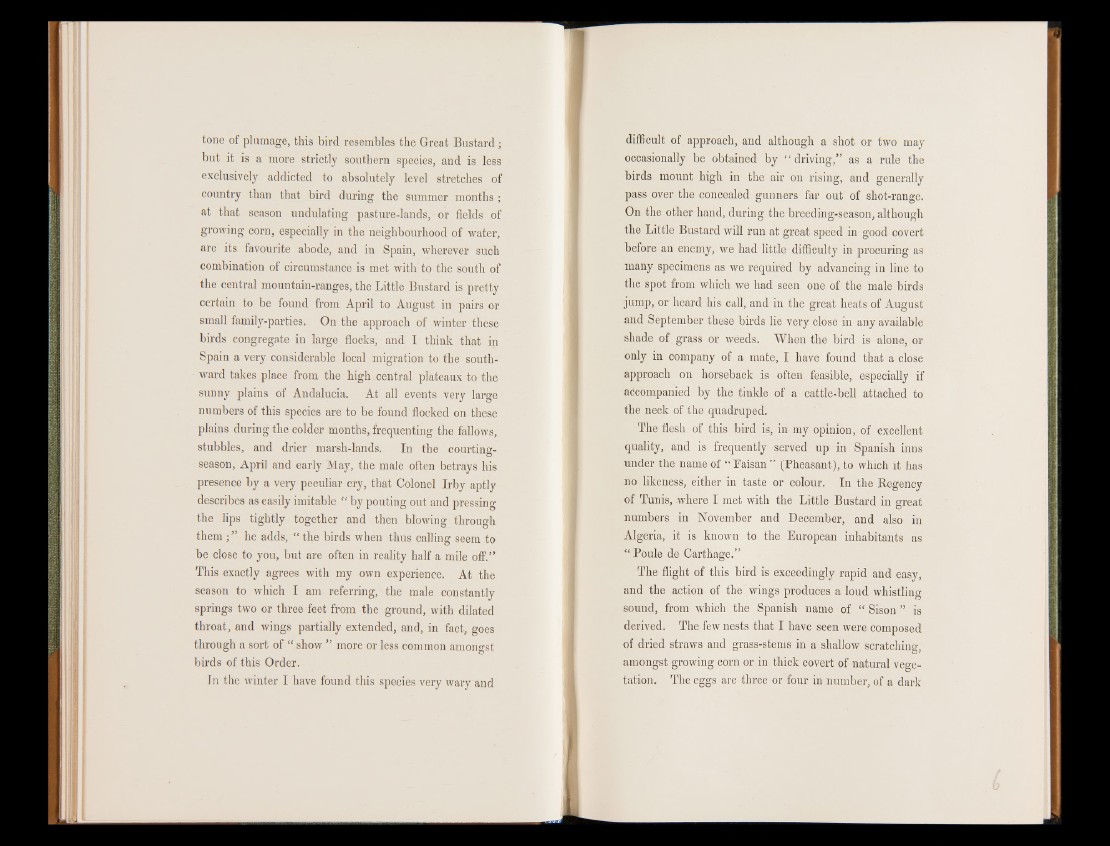
tone of plumage, this bird resembles the Great Bustard ;
but it is a more strictly southern species, and is less
exclusively addicted to absolutely level stretches of
country than that bird during the summer months ;
at that season undulating pasture-lands, or fields of
growing corn, especially in the neighbourhood of water,
are its favourite abode, and in Spain, wherever such
combination of circumstance is met with to the south of
the central mountain-ranges, the Little Bustard is pretty
certain to be found from April to August in pairs or
small family-parties. On the approach of winter these
birds congregate in large flocks, and I think that in
Spain a very considerable local migration to the southward
takes place from the high central plateaux to the
sunny plains of Andalucia. At all events very large
numbers of this species are to be found flocked on these
plains during the colder months, frequenting the fallows,
stubbles, and drier marsh-lands. In the courting-
season, April and early May, the male often betrays his
presence by a very peculiar cry, that Colonel Irby aptly
describes as easily imitable “ by pouting out and pressing
the lips tightly together and then blowing through
them he adds, “j the birds when thus calling seem to
be close to you, but are often in reality half a mile off.”
This exactly agrees with my own experience. At the
season to which I am referring, the male constantly
springs two or three feet from the ground, with dilated
throat, and wings partially extended, and, in fact, goes
through a sort of “ show ” more or less common amongst
birds of this Order.
In the winter I have found this species very wary and
difficult of approach, and although a shot or two may
occasionally be obtained by “ driving,” as a rule the
birds mount high in the air on rising, and generally
pass over the concealed gunners far out of shot-range.
On the other hand, during the breeding-season, although
the Little Bustard will run at great speed in good covert
before an enemy, we had little difficulty in procuring as
many specimens as we required by advancing in line to
the spot from which we had seen one of the male birds
jump, or heard his call, and in the great heats of August
and September these birds lie very close in any available
shade of grass or weeds. When the bird is alone, or
only in company of a mate, I have found that a close
approach on horseback is often feasible, especially if
accompanied by the tinkle of a cattle-bell attached to
the neck of the quadruped.
The flesh of this bird is, in my opinion, of excellent
quality, and is frequently served up in Spanish inns
under the name of “ Faisan ” (Pheasant), to which it has
no likeness, either in taste or colour. In the Regency
of Tunis, where I met with the Little Bustard in great
numbers in November and December, and also in
Algeria, it is known to the European inhabitants as
“ Poule de Carthage.”
The flight of this bird is exceedingly rapid and easy,
and the action of the wings produces a loud whistling
sound, from which the Spanish name of “ Sison ” is
derived. The few nests that I have seen were composed
of dried straws and grass-stems in a shallow scratching,
amongst growing corn or in thick covert of natural vegetation.
The eggs are three or four in number, of a dark